Day 2 of a three day Easter weekend tour today. It was another glorious, sunny day with more blue skies. It was warmer today, with easterly winds now, but still very pleasant weather to be out birding. We spent most of the day exploring the coast of north-west Norfolk.
We were heading over to the Wash coast first thing this morning, but as we drove along the road we noticed a shape in the window of an old barn by the road. We pulled up and could see it was a Little Owl, looking over the old rotten window ledge, sunning itself in the morning light.
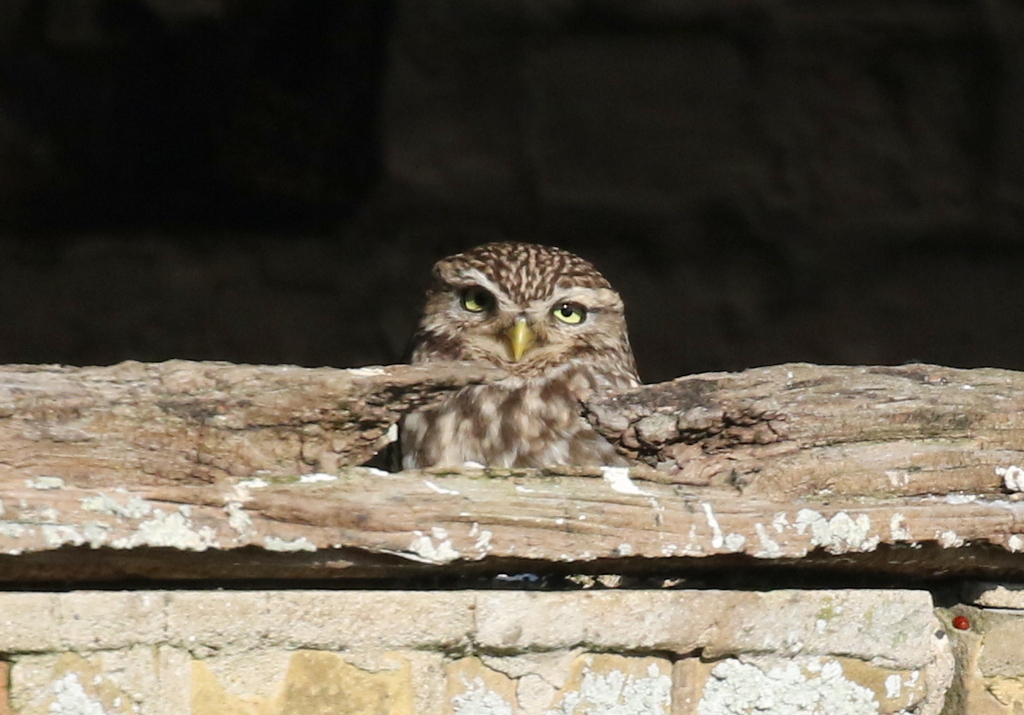
Our first destination for the day was Snettisham Coastal Park. As we walked in through the bushes, we could hear lots of warblers singing – Blackcap, Willow Warbler, Chiffchaff, Lesser Whitethroat and Common Whitethroat. We stood for a while and watched and gradually got views of each of them, to a greater or lesser extent. A female Bullfinch appeared in the willow tree along with a Willow Warbler and a Blackcap.
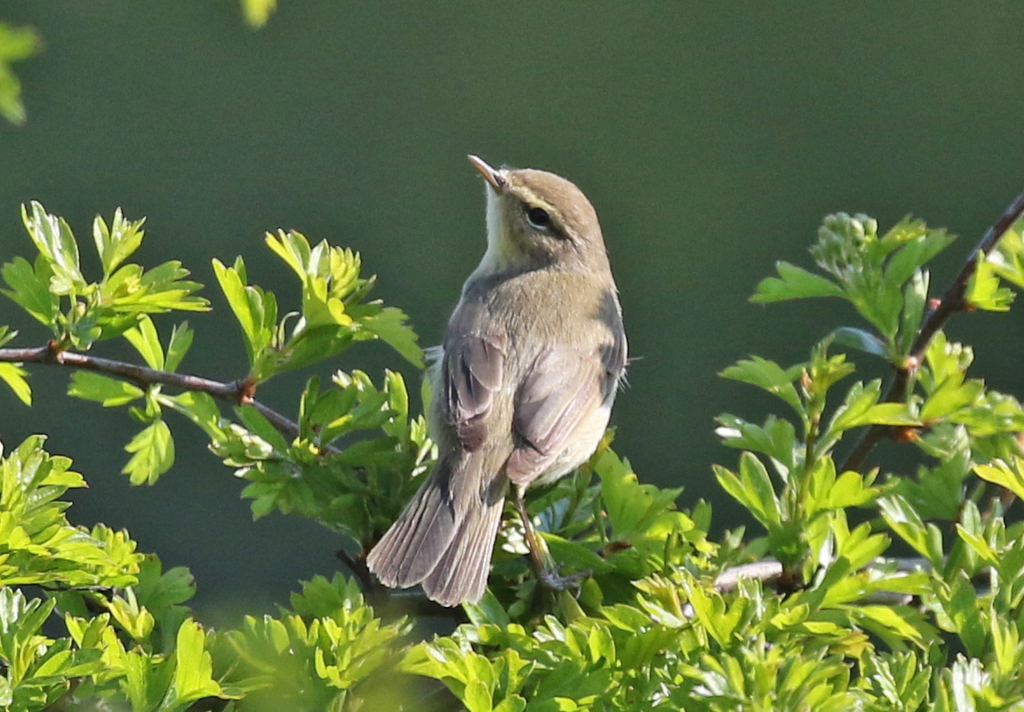
There were lots of Sedge Warblers singing too, over in the reeds beyond the bushes, and we could hear a Cetti’s Warbler shouting from away in that direction too. There seemed to be a steady procession of Mediterranean Gulls flying over calling too, which became a regular soundtrack for the morning from then on.
Continuing on north, we got out into a clear area. Several Wheatears were feeding on the short grass. At first, we found a couple of females but then a smart male appeared. As with the ones we saw yesterday, it had a rich burnt orange breast, a male Greenland Wheatear. A Greenfinch was feeding on the ground nearby with some Linnets.
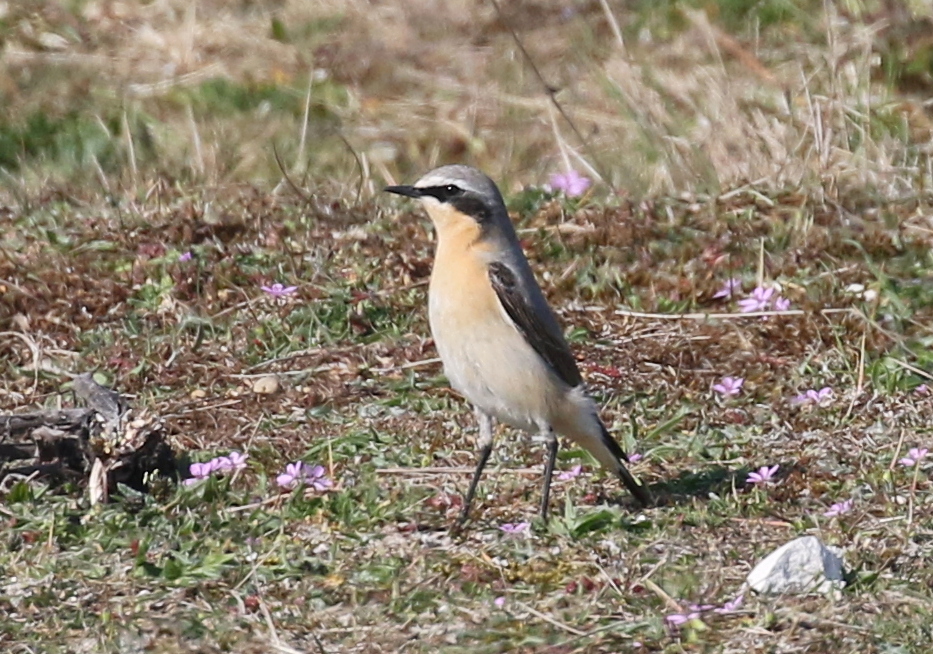
Going back into the bushes on the other side, there were yet more warblers singing. This is a great place to hear them, and they have clearly arrived in force in the last week, back from Africa and here for the breeding season. A Common Whitethroat was really going for it, singing and song-flighting between the bushes ahead of us. Presumably a recent arrival, staking out its territory and hoping to attract a mate. We could see its bright rusty wings, grey head and white throat.

Unfortunately there was a fire last year here, and afterwards a couple of big areas had been cleared. As we got out into the first of them, we found several more Wheatears feeding on the open ground. These used to be particularly good areas for Grasshopper Warbler, but after the fire and subsequent clearance of remaining scrub, the habitat is no longer suitable. Thankfully a few good areas of scrub still remain elsewhere on the site.
Up at the cross bank, we walked up onto the seawall. The tide was in on and the Wash was completely covered in water. Three Ringed Plovers were chasing each other on the stony beach below us.
We particularly wanted to look for some Yellow Wagtails here, as there had apparently been a Blue-headed Wagtail or hybrid with them earlier. But when we got to the cross bank, the cows were mostly sitting down, not what the wagtails like! We could see them flying round, and at least two of them flew off north, but at least two landed back down in amongst the cows.
As the cows started to stand up again and walk around, we could see there were more Yellow Wagtails than we had initially thought, five in total. But there had been twelve earlier and there was no sign of the Blue-headed Wagtail now, it must have flown off earlier. As the cows walked over to the inner seawall, the remaining five Yellow Wagtails flew off too, disappearing away to the north.
As we walked round to the inner seawall, three Whimbrels flew in and landed in the short grass between the banks. There must have been one here already as once we set up the scopes round on the other side, we could see four Whimbrels out in the grass. One walked down to the edge of a small pool to drink, where there were four sleeping godwits.
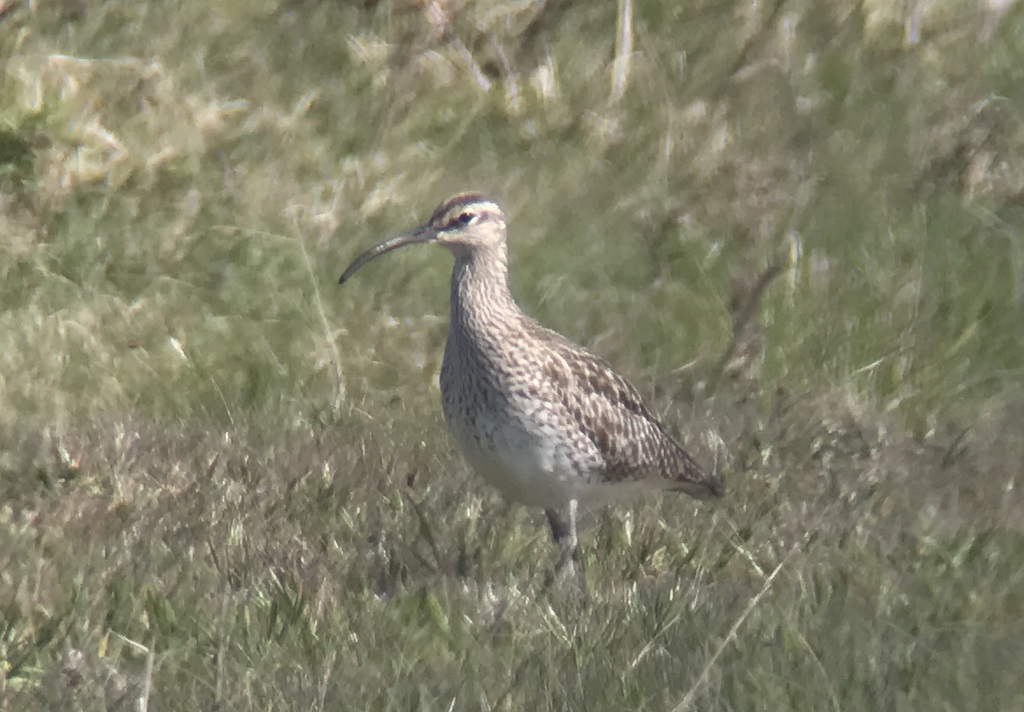
As we looked more closely, we could see there were three Black-tailed Godwits and a single Bar-tailed Godwit with them, presumably pushed off the Wash by the high tide and roosting here. The Bar-tailed Godwit was still in non-breeding plumage and very worn, but we could see its shorter legs, more obvious supercilium, and more heavily marked upperparts.
We walked back south along the inner seawall. Scanning the marshes the other side, we spotted a small group of Pink-footed Geese. Like we had seen yesterday, a very small number are still lingering here, whereas most have already gone north some time ago to stage on their way back to Iceland.
There were more warblers along here, including a particularly showy Sedge Warbler, which we stopped to watch. A Reed Warbler was singing in the reeds by the ditch on the edge of the marshes below us, its song more metronomic than the Sedge’s. There were still some good areas of scrub not touched by the fire on this side, but it was the middle of the day now and the Grasshopper Warblers seemed to have gone quiet.
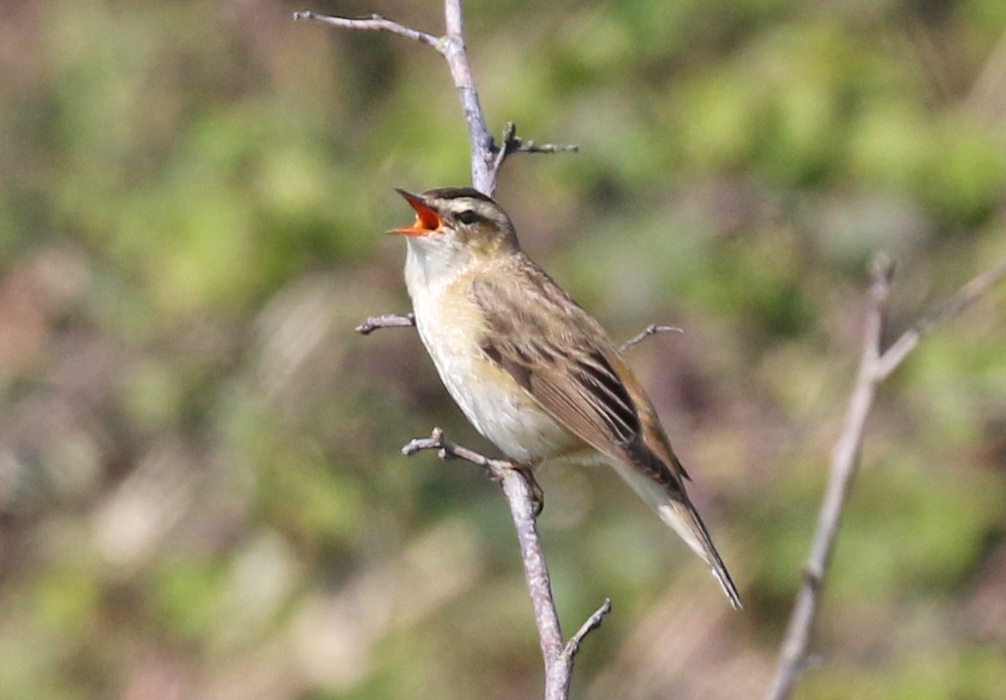
Back towards the road, we dropped down off the seawall and followed one of the paths into the bushes to cross back over to the other side. Finally, a Grasshopper Warbler started reeling. We had a fleeting glimpse of it as it dropped down into the brambles, then it went quiet. Thankfully, we had seen one yesterday but they are always great birds to hear and good to know that one or two continue to survive at this site.
Cutting back across to the minibus, we drove a short distance back along the road just as far as the entrance to the RSPB car park. The male Ring Ouzel was still in the field here, hopping around in the short grass amongst the molehills. We could see its striking white gorget. We walked round to the gate as the light would be better from there, but just as we got there something spooked it and it flew across to the far side.
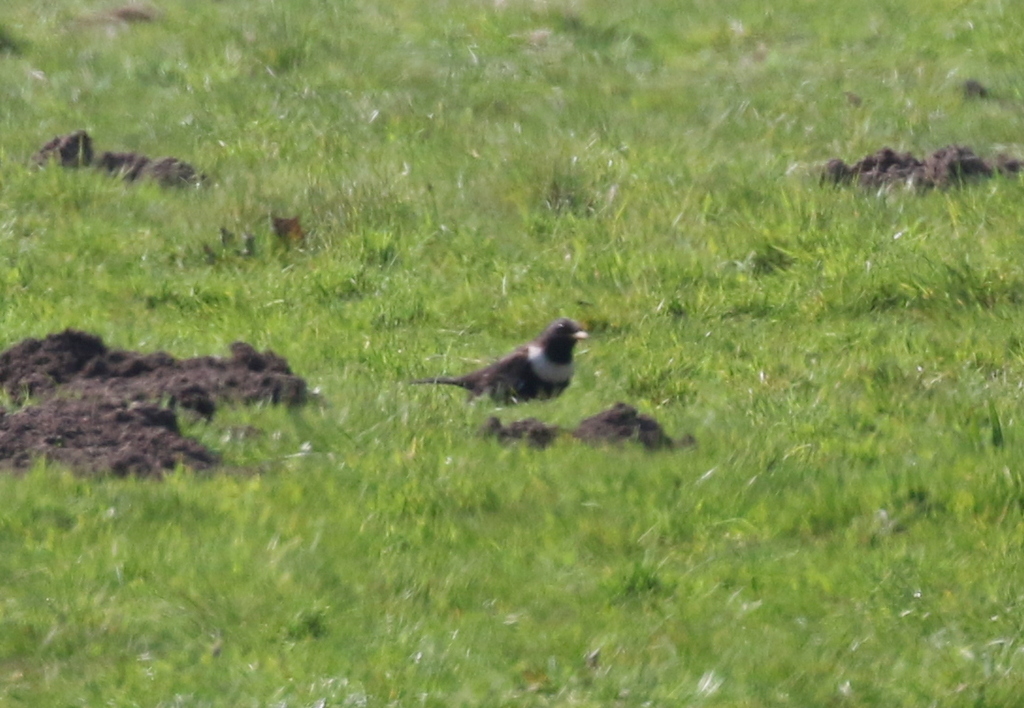
We made our way round to Titchwell next, although we had to take a detour inland to avoid the long queue of traffic backed up from the traffic lights, due to the number of people coming up for the Easter weekend to enjoy the good weather. Despite the number of people on the coast this weekend, Titchwell car park was surprisingly quiet and we had no trouble finding a space!
It was time for lunch, so we made good use of the tables in the picnic area. While we were eating, the warden emerged from the trees to say that there was a Spotted Flycatcher there. We could see it as it flew between the branches up in the tops.

After lunch, we headed out onto the reserve. There was no sign of the Whinchat which had been seen earlier around the grazing meadow. As we got out of the trees, a Reed Warbler was singing in reeds.
At the reedbed pool, we could see a male Red-crested Pochard towards the back, sporting its bright orange punk haircut. There were a few Common Pochard on here too, as well as a single Great Crested Grebe and a couple of Little Grebes. A male Marsh Harrier put on a good display, quartering over the reeds in front of us.
We could hear Bearded Tits calling and looked across to see them zipping back and forth over the reeds. Then three flew out over the water chasing each other, and shot up higher into the air above the reeds where they proceeded to whirl round after each other, presumably in some sort of territorial dispute.
A steady procession of Mediterranean Gulls flew past, in amongst the Black-headed Gulls, their distinctive calls alerting us each time to their imminent approach. The wing tips of the Mediterranean Gulls were translucent white against the sky, very different from the dusky underwings of the others.
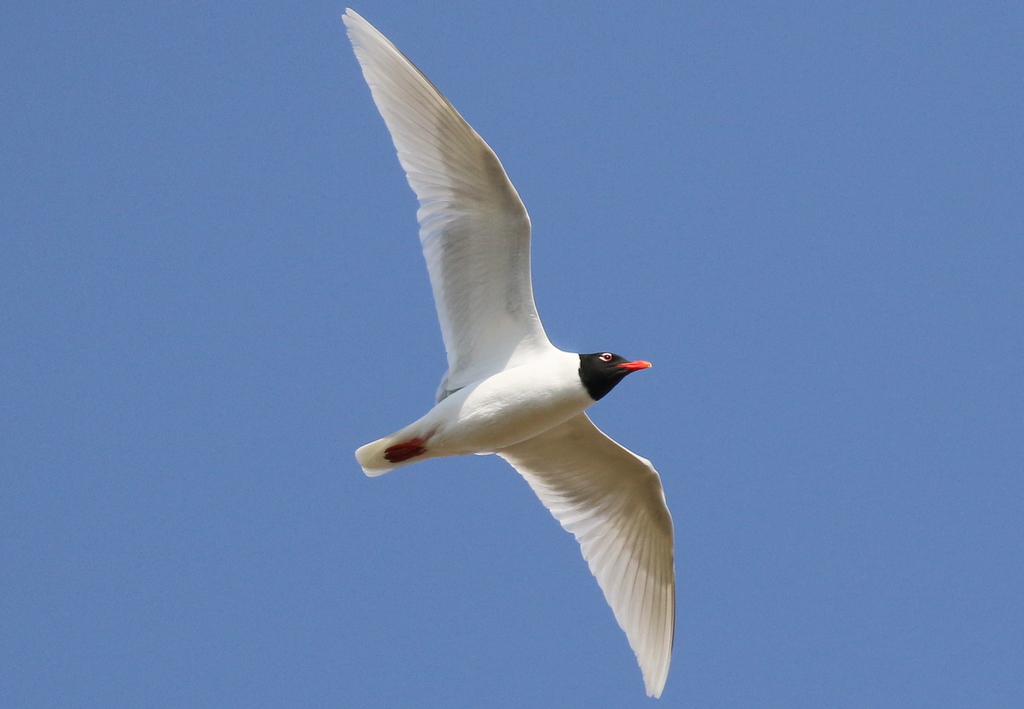
Out on the Freshmarsh, there were lots and lots of gulls. It seems to have been taken over by them again as a breeding colony! Scanning through them, we found a couple of small groups of Sandwich Terns and through the scope we could see their spiky black crests and yellow-tipped black bills.
There are still lots of Teal here, and quite a few Shoveler. Small groups of Brent Geese flew in and out from the saltmarsh on the Thornham side of the bank. It will not be long now before they are on their way back to Russia for the breeding season.
There were not many waders on here today. A few Avocets were feeding in the water or standing around on the islands. Further back, we could see one Ruff and a couple of Black-tailed Godwits. Two Little Ringed Plover were on the shore just beyond Parrinder Hide, so we went round there for a closer look. From the hide, we could see their golden yellow eye rings.
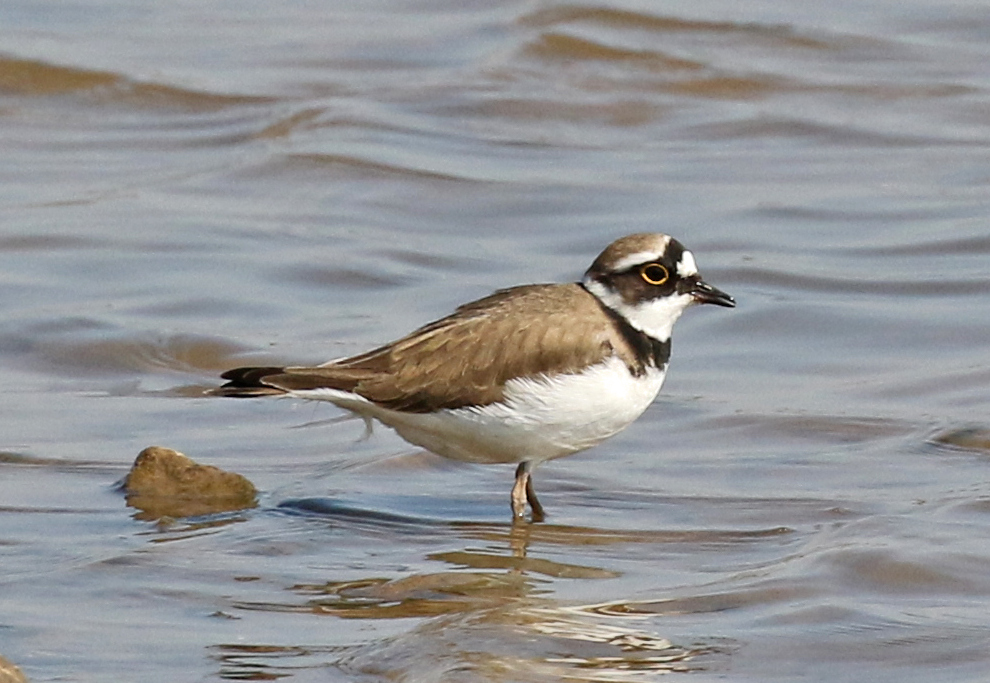
There was a closer view of the gulls from here too. We got a smart adult Mediterranean Gull in the scope, noting its jet black hood with white eyelids, bright red bill and white wing tips. Looking into the melee of gulls out on the fenced off ‘Avocet Island’, we could make out a lot of pairs of Mediterranean Gulls in the colony just on the basis of their darker black heads compared to the more numerous Black-headed Gulls (which actually have a chocolate brown hood!).
We made a bid for the sea next. As we passed Volunteer Marsh, we could see four Grey Plover and a single Bar-tailed Godwit down in the muddy channel at the far side. Out at the beach, the tide was right out. Perhaps not surprisingly, there were lots of people, dogs and even a couple of horses out on the and or clambering over the mussel beds. As a consequence, there was a dearth of waders today. There were a few Oystercatchers away to the left, and a little group of Dunlin and one or two Grey Plover with some Bar-tailed Godwits on the shore, at least until they were flushed by the horseriders.
Looking out to sea, a single Common Tern flew past just offshore. Out on the water, there were still quite a number of Great Crested Grebes. Further out, we found a couple of Red-breasted Mergansers, although given the distance and heat haze, it was not the best of views!
We had a brisk walk back, but when we got back to the van one of the group had disappeared. A search party was dispatched and eventually he was relocated. It turned out he had lost the rubber cap from the end of his binoculars and we had lost him when he had gone back to look for it!
A Purple Heron had been found this morning at Burnham Norton, where we had been yesterday afternoon, and we wanted to try to see it on our way back this afternoon. Thankfully there were spaces in the parking area when we arrived, and we set off along the path to the seawall. The male Marsh Harrier circled up right in front of us, carrying a stick in its talons, as the female circled above. He was probably showing off the nest material he had gathered to her!
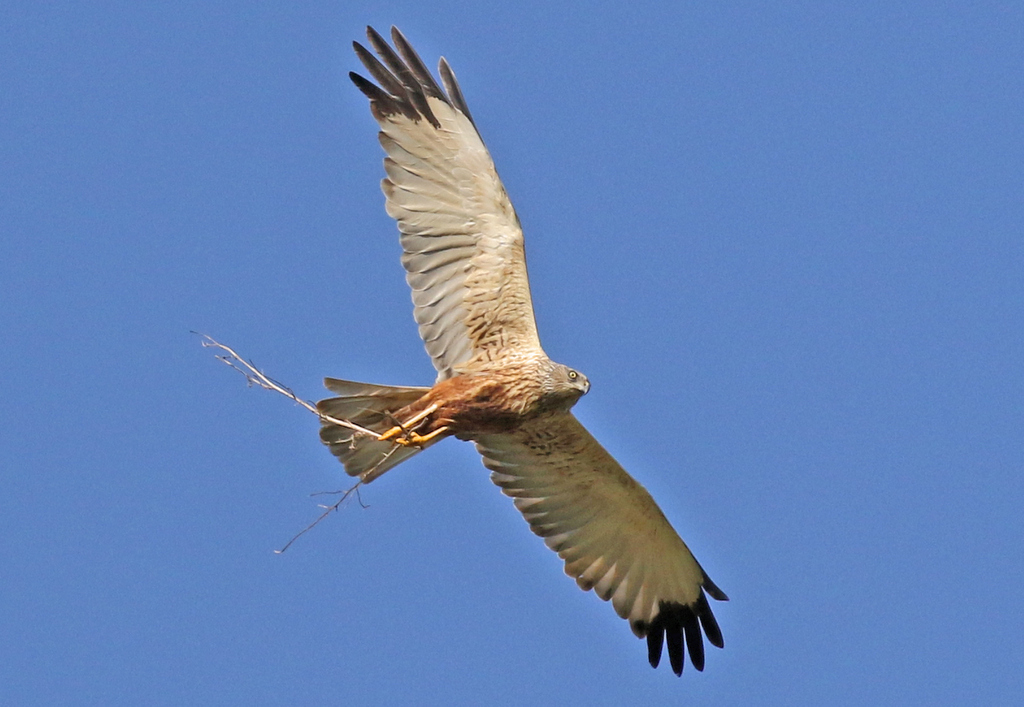
Up on the seawall, we found out why there were spaces in the car park as most people had gone already. Thankfully one person appeared and pointed us in the right direction and it didn’t take too long to find the Purple Heron hiding in a ditch. At first we could just see its head and long dagger-shaped bill when it looked up, then it walked up onto the edge of the field and we had a really good view of it.
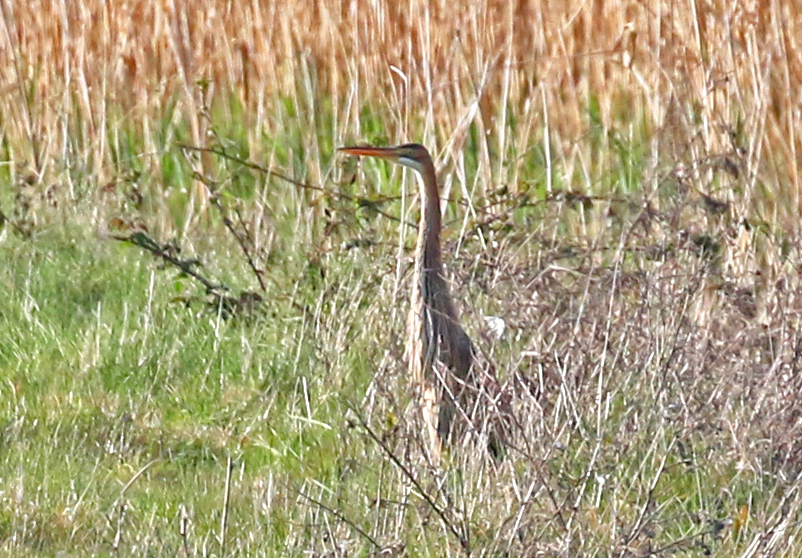
Then the Purple Heron flew over the fence, and landed in the next field, before walking down into the ditch that side. We could just see its head again. But that ditch was obviously not to its liking, as it walked back out and stood in the field for a couple of minutes, trying to work out what to do, before flying back over. It landed at the back of the field this time and looked around, before walking down into another areas of reeds to feed. Purple Heron is a very scarce visitor here, and this was a young bird in its 1st summer, which had probably overshot on its way up from Africa to its breeding grounds on the continent.
It was time to call it a day now, so we walked slowly back to the van. As we were driving back to the main road, we looked across to see four Fieldfares in the paddocks. These are winter visitors here, presumably stopping off to feed before heading out over the North Sea back to Scandinavia. It seemed an odd combination, to see Purple Heron one minute, then Fieldfares the next. It is not often you will find that combination so close together!
















